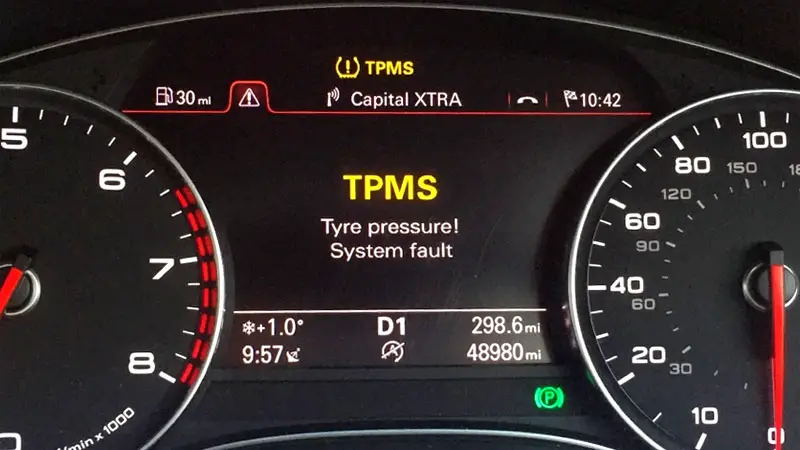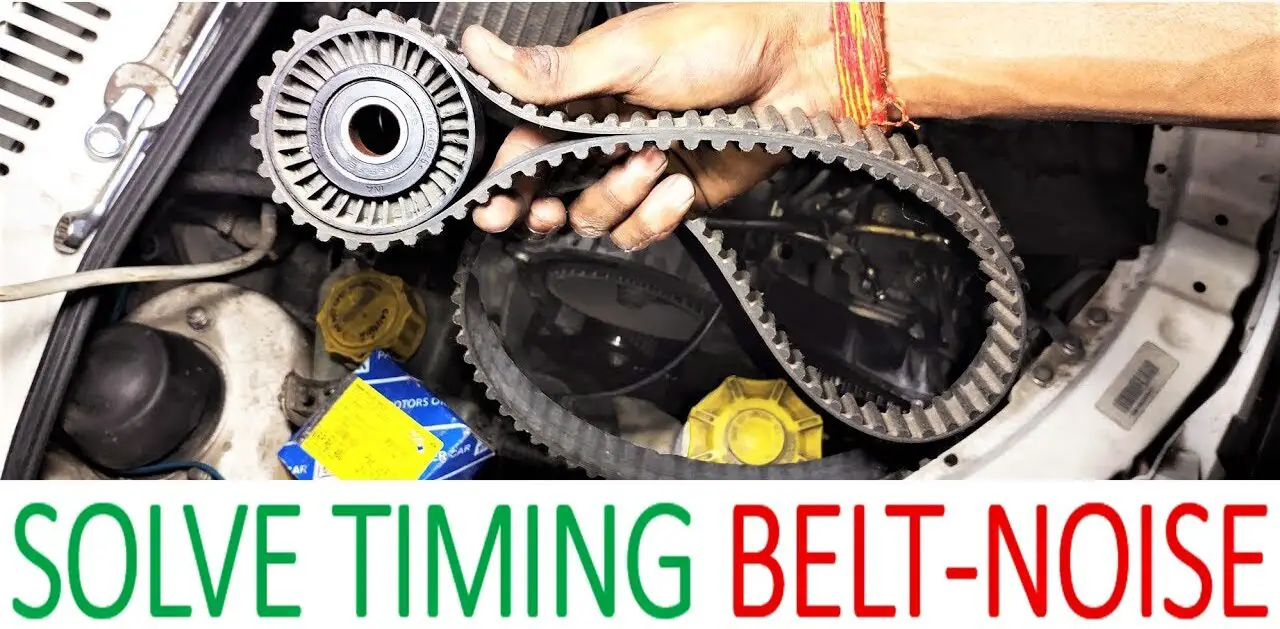If you’ve ever wondered about those unexpected tire pressure warnings in your Ford vehicle, you’re not alone.
In this article, we’ll break down the common issues surrounding Ford tire pressure sensor fault, shedding light on why they occur and what you can do to address them.
Let’s dive into the basics and demystify the world of tire pressure sensor problems in your Ford car or truck.
How Do Ford Tire Pressure Sensors Work?
Ever wondered how your car knows when the tires need attention? Well, it’s all thanks to the clever tech in Ford’s tire pressure sensors.
Imagine these sensors as little watchers on each tire.
Their job?
Keeping an eye on the air inside. Here’s the deal: they have a part that feels the pressure inside the tire.
When it’s too low or too high, these sensors shoot a quick message to your car’s computer.
That’s when you see the tire icon lighting up on your dashboard.
It’s like having a buddy who taps your shoulder when something’s up with your tires, giving you a heads-up before things get tricky.
So, the next time you see that little tire symbol blinking, know that your Ford tire pressure sensors are on the ball, making sure your ride stays safe and sound.
What are the Common Signs of Ford Tire Pressure Sensor Faults?
Maintaining optimal tire pressure is not just about a smooth ride – it’s a crucial aspect of vehicle safety and efficiency.
Ford vehicles, equipped with tire pressure sensors, rely on these components to keep drivers informed about the well-being of their tires.
However, like any technology, these sensors can encounter issues.
Understanding the common signs of Ford tire pressure sensor faults is essential for drivers to address potential problems promptly and ensure the overall health of their vehicles.
-
Illuminated Tire Pressure Warning Light
One of the most straightforward signs of a potential tire pressure sensor fault is the illumination of the tire pressure warning light on the dashboard. This indicator, resembling a tire with an exclamation mark, signals that the tire pressure monitoring system has detected an anomaly.
-
Inconsistent or Fluctuating Readings
Tire pressure readings displayed on the instrument cluster that fluctuate unexpectedly or seem inconsistent could be indicative of sensor malfunctions. These sensors are designed to provide accurate and stable readings, so any deviation may warrant further investigation.
-
Delayed or No Warnings
Tire pressure sensors are programmed to promptly alert drivers to variations in tire pressure. If there is a delay in receiving these warnings or if the system fails to notify the driver altogether, it may suggest a malfunction in the sensor’s communication with the vehicle’s computer.
-
False Alarms
False alarms, where the tire pressure warning light activates despite proper tire inflation, may point to sensor inaccuracies. This situation could arise due to sensor calibration issues or external factors causing misleading readings.
-
Low Tire Pressure Despite Inflation
If the tire pressure warning persists even after manually inflating the tires to the recommended levels, it may indicate a sensor misreading. This discrepancy between actual tire pressure and the sensor’s reported values requires attention to ensure accurate monitoring.
-
Sudden Changes in Tire Pressure
Normal fluctuations in tire pressure are gradual. Sudden and unexplained changes in pressure readings may signify a malfunctioning sensor. Consistent and reliable sensor data is crucial for timely intervention to prevent potential tire-related issues.
What are the Causes of Ford Tire Pressure Sensor Faults?

Knowing the underlying causes of tire pressure sensor faults in Ford vehicles is pivotal for proactive maintenance and effective troubleshooting.
While these sensors are designed to enhance safety and performance, several factors can contribute to their malfunction.
Here are some common reasons behind Ford tire pressure sensor faults:
-
Battery Failure
Tire pressure sensors are equipped with internal batteries responsible for powering the sensor’s operations. Over time, these batteries can wear out, leading to a loss of functionality or erratic behavior. Regularly checking and replacing sensor batteries can mitigate this issue.
-
Sensor Wear and Tear
Exposure to harsh environmental conditions, road debris, and general wear and tear can compromise the physical integrity of tire pressure sensors. Physical damage can hinder their ability to accurately measure tire pressure, necessitating replacement.
-
Electronic Interference
Modern vehicles are equipped with various electronic components, and interference among these systems can occur. Radio frequency interference, in particular, can disrupt the communication between tire pressure sensors and the vehicle’s computer, resulting in faulty readings.
-
Calibration Issues
Accurate tire pressure readings depend on precise sensor calibration. If sensors are not calibrated correctly during installation or maintenance, they may provide inaccurate readings, leading to false alarms or a failure to detect actual pressure issues.
-
Faulty Valve Stems
Tire pressure sensors are often integrated into the valve stems. If these valve stems become damaged or develop leaks, it can compromise the overall functionality of the sensor. Regular inspection of valve stems is essential for sensor health.
-
Corrosion and Oxidation
Exposure to moisture and corrosive elements can lead to the corrosion of sensor components. Corrosion can interfere with the electrical connections within the sensor, disrupting its ability to communicate with the vehicle’s computer and provide accurate readings.
-
Manufacturer Defects
In some cases, tire pressure sensor faults can be attributed to manufacturing defects. This could include issues with sensor components, assembly, or programming. If a vehicle exhibits persistent sensor problems, it may be worth exploring whether the sensors are subject to a manufacturer recall or warranty.
DIY Troubleshooting for Ford Tire Pressure Sensor Faults
Encountering issues with your Ford’s tire pressure sensors can be a bit perplexing, but fear not – there are some simple steps you can take for DIY troubleshooting. Before heading to the service center, consider these actions to identify and potentially resolve common tire pressure sensor problems:
Step 1: Check Tire Pressure Manually
Begin by manually checking the tire pressure with a reliable pressure gauge. Ensure that each tire is inflated to the recommended levels specified in your vehicle’s manual. If there’s a significant deviation from the recommended pressure, it could be an actual tire issue rather than a sensor fault.
Step 2: Inspect for Visible Damage
Take a close look at each tire and its respective tire pressure sensor. Look for visible signs of damage, such as cracks, leaks, or physical impacts. Damaged sensors may not function correctly and could be the source of the problem.
Step 3: Verify Sensor Placement
Confirm that each tire pressure sensor is securely attached to the valve stem. Sometimes, a loose or improperly placed sensor can result in inaccurate readings. Ensure that all sensors are correctly positioned according to the manufacturer’s guidelines.
Step 4: Check for Electronic Interference
Electronic interference can disrupt the communication between tire pressure sensors and the vehicle’s computer. If you recently installed electronic devices or experienced electrical work on your vehicle, consider whether these factors coincide with the onset of sensor issues.
Step 5: Perform Sensor Relearn Procedure
Some Ford vehicles require a sensor relearn procedure after tire rotation or sensor replacement. Refer to your vehicle’s manual for instructions on how to perform this relearn process. It helps the vehicle recognize the new sensor positions and ensures accurate readings.
Step 6: Inspect Valve Stems
Valve stems play a crucial role in housing tire pressure sensors. Check for any visible damage, leaks, or corrosion around the valve stems. Damaged valve stems can compromise the sensor’s functionality.
Step 7: Verify Battery Status
If your tire pressure sensors use internal batteries, check their status. Low or depleted batteries can lead to sensor malfunctions. Refer to your vehicle manual for guidance on accessing and replacing sensor batteries.
Step 8: Reset the System
In some cases, resetting the tire pressure monitoring system can resolve minor glitches. Refer to your vehicle’s manual for instructions on how to reset the system. This action can recalibrate the sensors and address temporary faults.
While these troubleshooting steps cover common issues, it’s important to note that tire pressure sensor problems can vary.
If DIY efforts do not resolve the issue or if you are uncertain about the cause, seeking professional assistance from a certified mechanic or visiting a Ford service center is recommended.
Professional diagnostics can pinpoint the root cause of the problem and ensure accurate and effective solutions for your Ford’s tire pressure sensor faults.
Preventive Measures: Maintaining Ford Tire Pressure Sensors
Ensuring the optimal performance of your Ford’s tire pressure sensors involves adopting preventive measures and routine maintenance. Here are key practices to help you maintain the health and accuracy of your tire pressure sensors:
-
Regular Tire Inspections
Conduct visual inspections of your tires, including the tire pressure sensors, during routine maintenance. Look for any signs of damage, leaks, or corrosion. Early detection of issues can prevent sensor malfunctions.
-
Proper Tire Inflation
Maintain the recommended tire pressure levels specified in your vehicle’s manual. Properly inflated tires not only contribute to better fuel efficiency and tire longevity but also reduce the strain on tire pressure sensors.
-
Gentle Tire Maintenance
When rotating or changing tires, handle the tire pressure sensors with care. Avoid harsh impacts or forceful manipulation, as these actions can lead to physical damage and compromise the sensors’ functionality.
-
Sensor Battery Checks
For sensors equipped with internal batteries, be aware of their lifespan. Periodically check and replace these batteries according to the manufacturer’s recommendations. Low or depleted batteries can result in sensor faults.
-
Avoiding Electronic Interference
Limit the installation of aftermarket electronic devices near tire pressure sensors. Electronic interference can disrupt the sensors’ communication with the vehicle’s computer, leading to inaccurate readings.
-
Routine Calibration
If your Ford vehicle requires sensor calibration after tire rotation or replacement, ensure that this procedure is performed according to the manufacturer’s guidelines. Proper calibration is essential for accurate and reliable sensor readings.
-
Protecting Valve Stems
Valve stems house tire pressure sensors, so keeping them in good condition is crucial. Check for leaks, damage, or corrosion and address any issues promptly. Damaged valve stems can compromise the sensors’ effectiveness.
-
Professional Inspections
Include tire pressure sensor checks during regular service appointments with a qualified mechanic or at your Ford dealership. Professional inspections can identify potential issues before they escalate, ensuring timely and effective solutions.
-
Stay Informed About Recalls
Keep an eye on manufacturer recalls related to tire pressure sensors. If there are known issues or updates, staying informed allows you to take proactive measures and address potential concerns promptly.
-
Addressing Faults Promptly
If you notice any of the common signs of tire pressure sensor faults, such as warning lights or inconsistent readings, address the issue promptly. Delaying repairs may lead to further complications and compromise the overall effectiveness of the tire pressure monitoring system.
FAQs – Ford Tire Pressure Sensor Fault
What does TYRE pressure sensor malfunction mean?
When your Ford’s tire pressure sensor indicates a malfunction, it signifies that there is an issue with one or more sensors responsible for monitoring the air pressure in your tires. This warning is a prompt to investigate and address potential problems to ensure accurate tire pressure readings and maintain vehicle safety.
Can you drive with a faulty tire pressure sensor?
Yes, you can still drive with a faulty tire pressure sensor, but it’s not recommended. While the vehicle is operational, a malfunctioning sensor may compromise your ability to receive timely warnings about low tire pressure. Regular manual checks of tire pressure are advisable until the sensor issue is resolved.
How do you turn off the tire pressure sensor on a Ford?
The process to turn off the tire pressure sensor on a Ford varies. In many cases, driving the vehicle for a few miles at a steady speed can reset the system. Alternatively, consult your vehicle’s manual for specific instructions or seek professional assistance to diagnose and address the sensor issue.
How can a tire sensor get damaged?
Tire pressure sensors can be damaged due to various factors, including:
- Physical impacts or collisions.
- Exposure to harsh environmental conditions.
- Corrosion of internal components.
- Faulty valve stems.
- Low or depleted internal sensor batteries.
How can I reset my tire sensor?
To reset a tire pressure sensor, refer to your vehicle’s manual for model-specific instructions. In many cases, it involves initiating a relearn procedure, which may include driving the vehicle for a certain distance at a specified speed. Follow the guidelines provided to ensure accurate recalibration.
How do you clear tire pressure on a Ford?
Clearing tire pressure warnings on a Ford often involves resolving the underlying issue causing the warning. Once the issue is addressed, driving the vehicle for a short distance at a consistent speed may automatically clear the warning. Refer to your vehicle’s manual for precise instructions.
Why is my tire pressure sensor fault but tires are fine?
A tire pressure sensor fault despite properly inflated tires could be attributed to issues such as:
- Sensor calibration problems.
- Electrical interference.
- Malfunctioning sensor components.
- Faulty communication between the sensor and the vehicle’s computer.
- Professional diagnostics are recommended to identify and rectify the specific cause.
How does Ford TYRE pressure sensor work?
Ford tire pressure sensors operate by monitoring the air pressure within each tire. These sensors, often integrated with the valve stems, use a pressure-sensitive element to detect variations in tire pressure. When deviations are detected, the sensors communicate with the vehicle’s computer, triggering a warning light on the dashboard to alert the driver to potential tire pressure issues. Regular calibration and maintenance are essential for accurate sensor performance.
Also Read: How To Fix Transmission Hot Idle Engine: Easy Step To Follow
Conclusion – Ford Tire Pressure Sensor Fault
In wrapping up, maintaining your Ford’s tire pressure sensors doesn’t have to be a puzzle.
Simple steps, like checking for damage, keeping the right tire pressure, and watching out for battery life, go a long way.
By giving these tiny guardians a bit of attention, you’re not just ensuring a smooth ride; you’re making sure your car’s safety features stay on point.
Remember, if you spot any warning lights or quirky readings, it’s like your car’s way of saying, “Hey, let’s sort this out.”
Whether it’s a quick DIY check or a visit to the professionals, keeping an eye on those tire pressure sensors keeps you rolling smoothly and safely.
So, here’s to hassle-free drives and tires that always have your back.
Safe travels!




